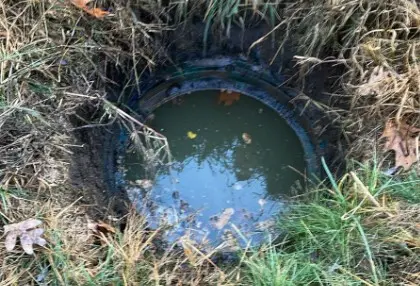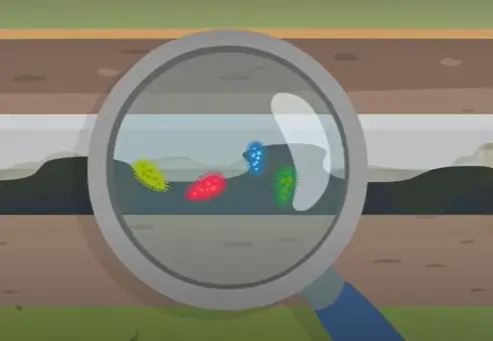Homeowners

Prevent Septic Failure with BioMaze® Drainfield Rejuvenation
Septic Issues? Don't Excavate, Rejuvenate
BioMaze® Consumes Biomat Restoring Flow in Your Septic
System.
What does BioMaze® do?
- Produces a high-dissolved-oxygen aerobic environment.
- Results in clear, odorless effluent rich in aerobic microorganisms.
- Restores failing drainfields without excavation, provided the drainfield will take some effluent.
Patents Pending

Reasons Why Septic Drainfields Fail:
- Soil Clogging due to Biomat: BioMaze® can correct this!
- Formation of a biomat that blocks the soil's ability to absorb effluent.
- Accumulation of solids in the drainfield due to inadequate pre-treatment in the septic tank.
- Overloading of Effluent: BioMaze® can help with this!
- Excessive water usage exceeding the drainfield's capacity.
- Hydraulic overloading caused by leaks, faulty plumbing, or improper design.
- Improper Design or Installation: BioMaze® can help with this!
- Inadequate sizing for the household's wastewater flow.
- Poor soil analysis leading to unsuitable site selection.
- Compaction of Soil: BioMaze may be able to help with this!
- Heavy vehicles or machinery compressing the soil over the drainfield.
- Reduced permeability impeding effluent absorption.
- Root Intrusion: BioMaze® can help with this if it is a combination of roots and biomat.
- Roots from nearby trees or shrubs infiltrating and clogging drain pipes.
- Chemical or Biological Contamination: BioMaze® CANNOT help with this.
- Use of harsh chemicals killing beneficial bacteria in the septic system.
- Introduction of fats, oils, grease (FOG), or non-biodegradable items clogging pipes and soil.
- High Water Table or Flooding: BioMaze® CANNOT help with this.
- Seasonal or persistent water saturation reducing soil's ability to absorb effluent.
Note: RioVation® partners with onsite wastewater contractors to diagnose your specific issue(s) and provide tailored recommendations.

What Causes Biomat?
- Biomat forms in septic drainfields as a result of natural processes that occur when wastewater is treated in the soil. Here's a breakdown of why it forms:
- Organic Matter in Effluent: The wastewater exiting the septic tank contains organic matter, nutrients, and microorganisms. These materials are carried into the drainfield, where they encounter soil and oxygen.
- Microbial Activity: Microorganisms in the soil, such as bacteria and fungi, begin to break down the organic matter. Over time, these microbes accumulate at the soil interface, creating a layer known as biomat.
- Anaerobic Conditions: The biomat layer is often anaerobic (low in oxygen) because it restricts the flow of oxygen into the soil. This anaerobic environment slows down the decomposition process and contributes to the continued buildup of biomat.
- Filtration and Nutrient Capture: The biomat acts as a natural filter, capturing fine particles, nutrients, and pathogens from the effluent. However, excessive accumulation can lead to clogging, reducing the soil's ability to absorb and treat wastewater effectively.
- High Organic Load: A high organic load in the effluent, often caused by poorly maintained septic systems, can accelerate biomat formation. This occurs when the septic tank fails to adequately separate solids, sending more organic material into the drainfield.
- While biomat formation is a normal part of septic system function, excessive buildup can cause drainfield failure by reducing permeability and leading to effluent surfacing or backup into the system.
- Regular septic tank maintenance and the use of advanced treatment solutions can help manage biomat formation and maintain drainfield efficiency.
BioMaze® is highly effective at rapidly eliminating biomat from drainfields!
Treating in the Soil vs Treating in the Tank
- Up to 50% of U.S. soils are unsuitable for proper soil-based treatment.
- Soil conditions are unpredictable and affected by hostile climates.
- Most drainfields develop biomat over time and fail; the EPA estimates a drainfield lifespan of 15–20 years.
- Additional system loads can exceed design capacity, leading to hydraulic overload.
- Tank-Based Treatment Advantages:
- Controlled and predictable environment.
- Point-source verifiable—easily monitored and tested.
- BioMaze® prevents failures and restores biomat-clogged drainfields.
Why are We Planning to Fail?
- Current septic system site plans require a "designated replacement area" for future drainfield failures.
- Reserve areas are protected land, ensuring usability when failures occur.
- BioMaze® offers a proactive alternative to premature drainfield replacement.
What does it look like?
- Uses a quiet, energy-efficient HIBLOW linear air pump with ceramic stone fine air diffusion to create oxygen-rich conditions.
- Fixed-film media pods support aerobic microorganism growth, adjusting thickness based on organic loading.
Patents Pending
Creates Environment for Microorganisms to Grow
- Creates suspended biofilm microorganisms in the treatment tank.
Crystal Clear and Odorless Effluent
- Effluent produced from BioMaze® is typically clear, odorless, and free of solids—even in single-compartment tanks.
Alabama Case Study
- Single-compartment tank with failing drainfield.
- Customer faced a $20,000 engineered mound system replacement.
- BioMaze® rejuvenated the existing drainfield, producing clear, odorless effluent.
Eats Sludge in Tank and Drainfield
- Installed May 2021: Initial sludge sample showed ~9 inches.
- 9 months later: BioMaze® eliminated sludge in the treatment compartment.
- If it reduces tank sludge, it also rejuvenates drainfields by reducing biomat sludge.
How does it do it?
SBG™ SUSPENDED BIOFILM GENERATOR™
Watch this video of the Product Designer, Gig Drewery, describing SBG™
Onsite Professional Testimonial
- Protects the environment.
- Affordable drainfield alternative.
- Builds homeowner trust and satisfaction.
- Combines customer service with profitability.
Homeowner Testimonial
- "Saved me thousands of dollars and my front yard."
- "The water is clearer than my tap water!"
- "No odor! How can it make water that clear?"